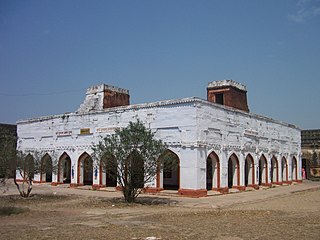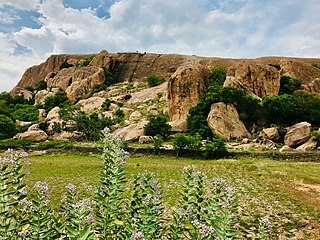
Lalitpur is a city and a municipal board in Lalitpur District, India in the Indian state of Uttar Pradesh. It is also district headquarters of Lalitpur district. The city is part of Bundelkhand region.

Chanderi, is a town of historical importance in Ashoknagar District of the state Madhya Pradesh in India. It is situated at a distance of 127 km from Shivpuri, 37 km from Lalitpur, 55 km from Ashok Nagar and about 46 km from Isagarh. It is surrounded by hills southwest of the Betwa River. Chanderi is surrounded by hills, lakes and forests and is spotted with several monuments of the Bundela Rajputs. It is famous for ancient Jain Temples. Its population in 2011 was 33,081.

Prithviraja III, popularly known as Prithviraj Chauhan or Rai Pithora, was a king from the Chauhan (Chahamana) dynasty who ruled the territory of Sapadalaksha, with his capital at Ajmer in present-day Rajasthan in north-western India. Ascending the throne as a minor in 1177 CE, Prithviraj inherited a kingdom which stretched from Thanesar in the north to Jahazpur (Mewar) in the south, which he aimed to expand by military actions against neighbouring kingdoms, most notably defeating the Chandelas.

The Chandelas of Jejakabhukti was an Indian dynasty in Central India. The Chandelas ruled much of the Bundelkhand region between the 9th and the 13th centuries. They belonged to the Chandel clan of the Rajputs.

Firozabad district is one of the western districts of the Indian state of Uttar Pradesh, which has Firozabad city as its district headquarters. Administratively, the district is a part of the Agra division.

Ajmer district is a district in the Indian state of Rajasthan. It is part of the Ajmer division–one of the ten administrative divisions of Rajasthan. The city of Ajmer is the district headquarters. The district is situated in the center of Rajasthan, and is bounded by Didwana Kuchaman district to the north, Jaipur Rural and Dudu to the north-east, Tonk to the east, Kekri and Beawar to the south, and Nagaur to the west. It has an area of 8,481 km2 (3,275 sq mi), and a population of 2,583,052.

Halasi is a town in Khanapur Taluk, Belgaum District in Karnataka, India. It is 14 km from Khanapur and about 25 km from Kittur. As known from inscriptions, the ancient name of the town was Palāśikā. A centre of the early Kadamba Dynasty, it was a minor capital of the Goa Kadambas (980-1025). The town is notable for a series of medieval temples. The most famous are the Varāha Narasiṃha temple and Suvarṇeśvara temple in the town, and a third temple of Rāmeśvara. On a hill about 1.9 km. south-west of the town is a pilgrimage place known as Rāmatītha.

Bijoliya is a census town in Bhilwara district in the state of Rajasthan, India and is surrounded by nature and waterfalls and is famous for Tapodaya Teerth Kshetra and Mandakini Temple.
Pauni is a town and a Municipal Council in Bhandara district in the Indian state of Maharashtra. Now it has National Highway NH-247. Pauni is also known as Kashi of Vidarbha due to its wide swath of temples.
Sadalga is a municipal town in Chikodi Taluka in the Belagavi district of Karnataka, India. It is best known as the birth place of Digambar Jain Acharya Shri Vidyasagar Ji Maharaj. His home is recently converted into a museum.

Tosham is a town and a Gram Panchayat on the foot of Tosham Hill range in Bhiwani district in the Indian state of Haryana. It has been awarded the title of "Adarsh Village". It is situated in the foothill of Tosham hill range of Aravali Mountain Range. The hill has several historic places, such as forts, carvings, paintings, temples, sacred ponds, dating as far back 1800 years. It is a rural area.

The term Alha Khand is used to refer to poetic works in Hindi which consists of a number of ballads describing the brave acts of two 12th century Banaphar Rajput heroes, Alha and Udal, generals working for king Paramardi-Deva (Parmal) of Mahoba against Prithviraj Chauhan of Ajmer. The works has been entirely handed down by oral tradition and presently exists in many recensions, which differ from one another both in language and subject matter. The Bundeli, Bagheli, Awadhi, Bhojpuri, Maithili, and Kannauji recensions are the most well known among these.

The Bhojshala is a historic building located in Dhar, Madhya Pradesh, India. The name is derived from the celebrated king Bhoja of the Paramāra dynasty of central India, a patron of education and the arts, to whom major Sanskrit works on poetics, yoga and architecture are attributed. The architectural parts of the building proper are of different periods but mainly date the 12th century; the Islamic domed tombs in the wider campus were added between the fourteenth and fifteenth centuries.

Deogarh is a village in Lalitpur district of the Indian state of Uttar Pradesh. It is located on the right bank of Betwa River and to the west of Lalitpur hills. It is known for Gupta monuments and for many ancient monuments of Jain origins inside and outside the walls of the fort.

Samanar Hills, also known as Samanar Malai or Amanarmalai or Melmalai, is a rocky stretch of hills located near Keelakuyilkudi village, 10 kilometres (6.2 mi) west of Madurai city, Tamil Nadu, India. They stretch east–west over 3 kilometers towards Muthupatti village. These rocky hillocks are home to many Jain and Hindu monuments. The hill has been declared as a protected monument by the Archaeological Survey of India.

Pathari is a town in Vidisha district, Many tourist attractions in the Indian state of Madhya Pradesh.

Kalugumalai Jain beds in Kalugumalai, a panchayat town in Thoothukudi district in the South Indian state of Tamil Nadu, are dedicated to the Jain religious figures. Constructed in rock cut architecture, the unfinished temple is believed to have been built during the reign of Pandyan king Parantaka Nedunjadaiya. The rock-cut architecture at Kalugumalai is an exemplary specimen of Pandyan art. The other portions of Kalugumalai houses the 8th century unfinished Shiva temple, Vettuvan Koil and Kalugasalamoorthy Temple, a Murugan temple at the foothills.
Deo Barunark or Deo (देवबरनार्क) is a village dating back to the Maurya period. It is a large village in the Tarari block of Bhojpur district, Bihar, India. The village has a total of 735 families.

Udaypur is a town in Vidisha district of the Indian state of Madhya Pradesh, near Vidisha city. It is the site of a well-preserved Śiva temple, a monument of national importance protected by the Archaeological Survey of India.
Sihoniya is a town in Morena district, in the Indian state of Madhya Pradesh. The town is sometimes referred to as Suhania; in medieval times it was called Siṃhapānīya. The settlement has a long history and a number of notable monuments, one being of national importance and protected by the Archaeological Survey of India.

















